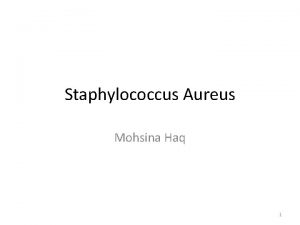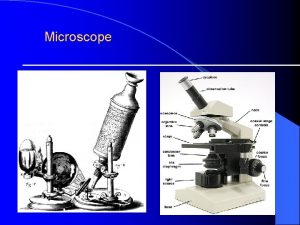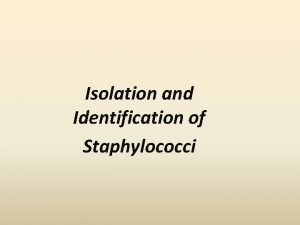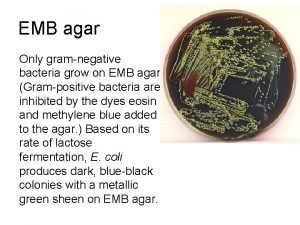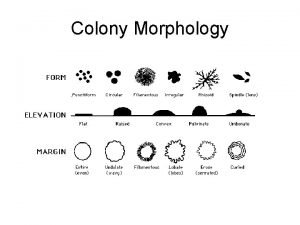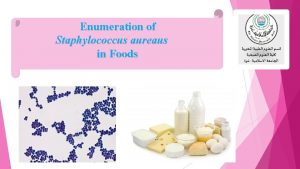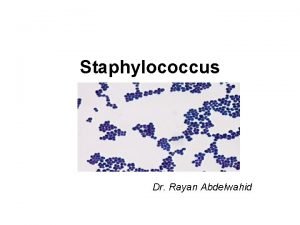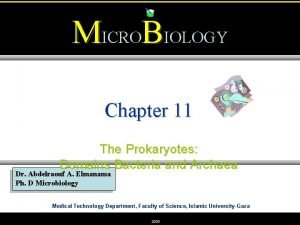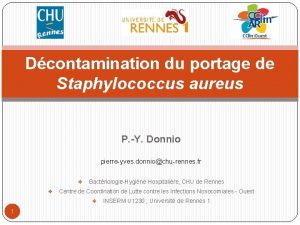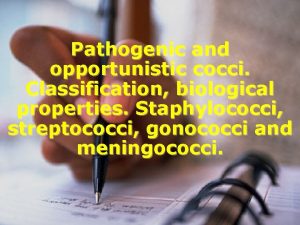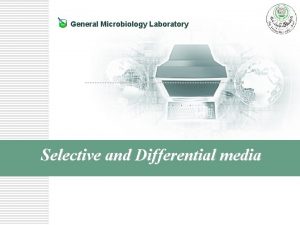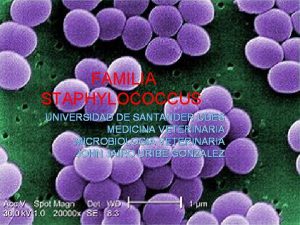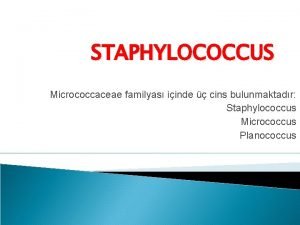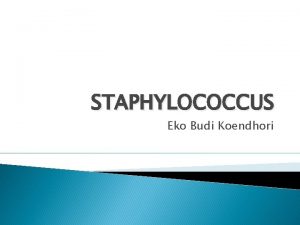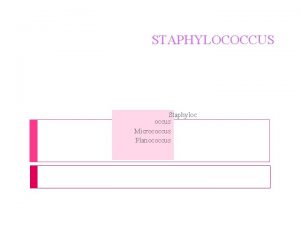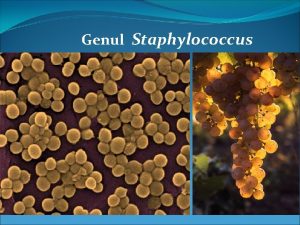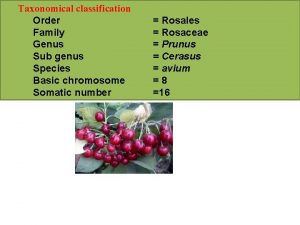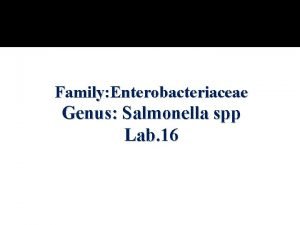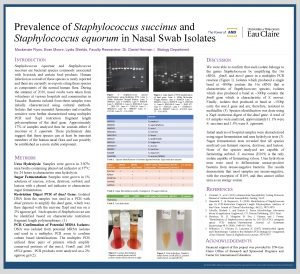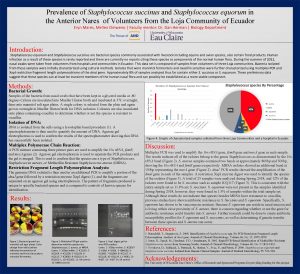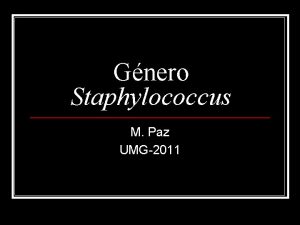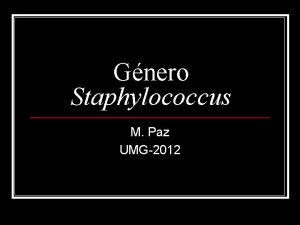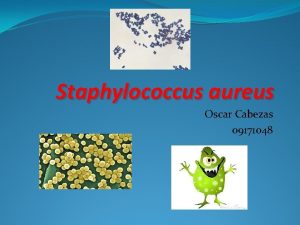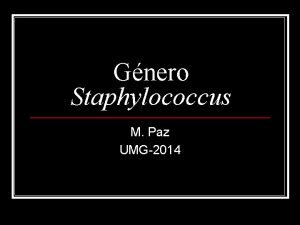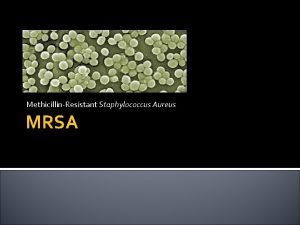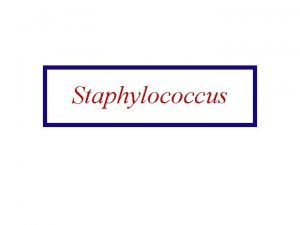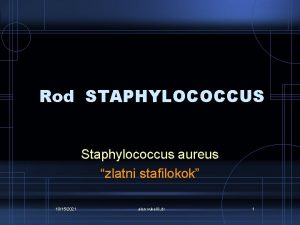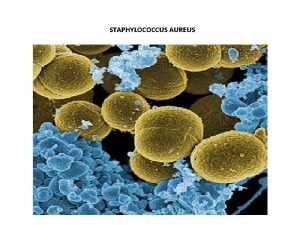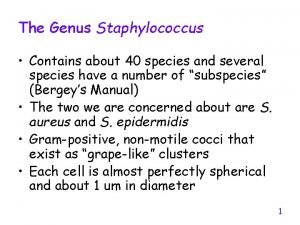Genus Staphylococcus Classification Family Micrococcaceae Genus Micrococcus and


























- Slides: 26

Genus Staphylococcus

Classification • Family Micrococcaceae • Genus Micrococcus and Staphylococcus • Species §S. aureus §S. Saprophyticus (Staph. citrus) §S. Epidermidis (Staph. albus)

Morphology ü Gram positive ü Cocci in Grape-like clusters ü Facultative to aerobic ü Extracellular in host ü Colonies: white, yellow, gold - round ü Non- motile ü Capsule – some strains ü Catalase positive small cocci in clusters stained purple

Staphylococcus aureus • Staphylococcus aureus is the most virulent pathogenic species in the group • ü. Gram positive üCocci in Grape-like clusters üFacultative to aerobic üExtracellular in host üNon- motile üCapsulated üCatalase positive üCoagulase positive

Cultural Characteristics • Media üGrows on ordinary bacterial medium at 37 C • • Facultatively anaerobic Non-spore-forming Non-motile Endopigment

• On nutrient agar • Golden yellow colonies

St ap hy lo co cc u s au r eu s Mannitol Salts Agar (MSA)

Blood agar plate Cream colored mucoid large round distinctively beta -hemolytic colonies large zone of hemolysis β-hemolysis

Biochemical characteristics • • • Catalase +ve Coagulase +ve Ferment manitol Oxidase –ve Liquefies gelatin &produce acid and clot on litmus milk

Catalase 2 H 2 O 2 + 2 H 2 O

2 3 Crush ampule Oxidase No change Negative 4 1 Purple Positive

Coagulase Fibrinogen Fibrin Coagulase +Ve Coagulase -Ve

Host-Parasite Relationship Staphylococci are a normal flora (Commensal)and do not usually cause disease, but when they are introduced into bite wounds, skin aberrations, hormonal, immuno-deficiency etc. , are important in pathogenesis. Abscesses cystitis mastitis Pyoderma exfoliative dermatitis Otitis externa Endogenous

Virulence Factors of Importance • Cellular components ü Protein A ü Cell Wall ü Capsule (Slime: type 5 Bovine & type 8 Caprine/Ovine) • Toxins ü Alpha, Beta, Gamma and Delta toxins ü Leucocidin ü 11 (SE) Enterotoxins A, B, C 1, C 2 D, and E (1 C for 30 min) ü TSST-1 is a enterotoxin F “superantigen”-cytokine storm in human beings. 20 k. Da to 30 k. Da similar in shape ü Exfoliative toxin (s. ET) of S. aureus and sh. ET of S. hyicus* * (SSSS) (glutamate specific serine proteases) • Enzymes ü Coagulase ü Lipase

Colonization of host tissues • Polysaccharide capsule • Protein A • Teichoic acid - ribitol type • Clumping Factor – cell-bound coagulase Bacterial spread in tissues • Hyaluronidase (spreading factor) • Staphylokinase (fibrinolysin) • Coagulase • Hemolysins

Host factors Things known to influence chance of infection include: Immunosuppression Overwhelming infection Treatment with broad spectrum antimicrobials


Important Disease in Animals

Botryomycosis It is pyogenic infection characterized by granulomata formation in skin and sc tissue. • Sounds like a fungal infection, but its not! • Caused by S. aureus • Udder infection occurs in: üSows üMares üCows • Spermatic cord infection following castration • Sulfur granules in advanced cases

Bumble foot Purulent synovitis

Mastitis • Transmission –Colonization of teat canal (milk and body sites) –Milking machines, milkers’ hands, faulty milk lines • Clinical signs Gangrene setting in ü Sub-clinical • Reduced milk production • High somatic cell count ü Clinical Inflamed udder • Suppurative, gangrenous or chronic *gangrenous form in first-calf heifers due to alpha toxin

Laboratory diagnoses 1 - Sampling 2 - Film staining 3 - Culture 4 - Biochemical test 5 - Phage typing 6 - Animal inoculation 7 - PCR

Phage typing

Treatment of choice: penicillinase-resistant Penicillins or Penicillins + clavulanic acid, but abscess penetration is a problem (surgical intervention may be necessary) Long-acting DRY COW treatment for mastitis Preventive measures include proper milking hygiene, prevention of risk factors and avoiding indiscriminant use of antimicrobials

• Penicillin-resistance (Antibiotic sensitivity test) ü ü Are commonly resistant to Penicillins Use penicillinase-resistant Penicillins (semi-synthetic) Use Penicillins with clavulanic acid Methicillin • Abscess penetration ü Surgical removal and local treatment may be necessary • Withdrawal times ü Dry cow versus lactating herd treatments

MRSA Methicillin resistant Staph. aureus is a type of staph bacteria that is resistant to certain antibiotics called betalactams. These antibiotics include methicillin and other more common antibiotics such as oxacillin, penicillin, and amoxicillin. The most MRSA infections are skin infections.
 Micrococcaceae family
Micrococcaceae family Micrococcaceae e streptococcaceae
Micrococcaceae e streptococcaceae Classification of staphylococcus
Classification of staphylococcus Difference selective and differential media
Difference selective and differential media Catalase
Catalase Enterobacter aerogenes on mannitol salt agar
Enterobacter aerogenes on mannitol salt agar Micrococcus luteus elevation
Micrococcus luteus elevation Dinoflagellates literally means _____.
Dinoflagellates literally means _____. Cat classification chart
Cat classification chart Genus family class order
Genus family class order Phylum class order
Phylum class order Classification of maize seed
Classification of maize seed Kingdom family genus species
Kingdom family genus species Classification of living things quickchek
Classification of living things quickchek 3 domain system of classification
3 domain system of classification Finding order in diversity
Finding order in diversity Domain kingdom phylum class order family genus species
Domain kingdom phylum class order family genus species All staphylococci are catalase positive
All staphylococci are catalase positive Testul coagulazei
Testul coagulazei Confirmation test for staphylococcus aureus
Confirmation test for staphylococcus aureus Staphylococci
Staphylococci Prokaryotes domains
Prokaryotes domains Staphylococcus
Staphylococcus Staphylocoque mrs1
Staphylocoque mrs1 Staphylococcus
Staphylococcus Differential media vs selective media
Differential media vs selective media Estafilococos catalasa positiva
Estafilococos catalasa positiva


